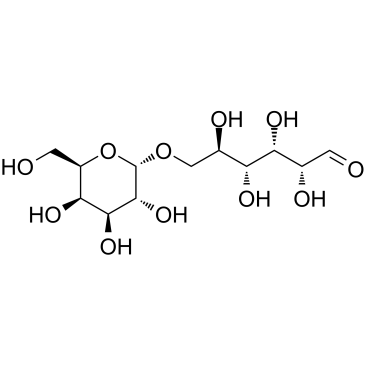蜜二糖 水合物

蜜二糖 水合物结构式

|
常用名 | 蜜二糖 水合物 | 英文名 | Melibiose |
|---|---|---|---|---|
| CAS号 | 585-99-9 | 分子量 | 342.297 | |
| 密度 | 1.8±0.1 g/cm3 | 沸点 | 662.8±55.0 °C at 760 mmHg | |
| 分子式 | C12H22O11 | 熔点 | 182ºC (dec.)(lit.) | |
| MSDS | 中文版 美版 | 闪点 | 354.6±31.5 °C |
|
Transcription of two adjacent carbohydrate utilization gene clusters in Bifidobacterium breve UCC2003 is controlled by LacI- and repressor open reading frame kinase (ROK)-type regulators.
Appl. Environ. Microbiol. 80(12) , 3604-14, (2014) Members of the genus Bifidobacterium are commonly found in the gastrointestinal tracts of mammals, including humans, where their growth is presumed to be dependent on various diet- and/or host-derived carbohydrates. To understand transcriptional control of bi... |
|
|
Functions of Armigeres subalbatus C-type lectins in innate immunity.
Insect Biochem. Mol. Biol. 52 , 102-14, (2014) C-type lectins (CTLs) are a superfamily of calcium-dependent carbohydrate binding proteins containing at least one carbohydrate-recognition domain (CRD) and they are present in almost all metazoans. Insect CTLs may function as pattern-recognition receptors an... |
|
|
Immunopathology of desialylation: human plasma lipoprotein(a) and circulating anti-carbohydrate antibodies form immune complexes that recognize host cells.
Mol. Cell Biochem. 403 , 13-23, (2015) Human plasma lipoprotein(a) [Lp(a)], the dominant lipoprotein in atherosclerotic plaques, contains an apo(a) subunit of variable size linked to the apoB subunit of a low-density lipoprotein (LDL) molecule. Circulating lipoprotein immune complexes (ICs) assaye... |
|
|
Mechanistic evaluation of MelA α-galactosidase from Citrobacter freundii: a family 4 glycosyl hydrolase in which oxidation is rate-limiting.
Biochemistry 50(20) , 4298-308, (2011) The MelA gene from Citrobacter freundii, which encodes a glycosyl hydrolase family 4 (GH4) α-galactosidase, has been cloned and expressed in Escherichia coli. The recombinant enzyme catalyzes the hydrolysis of phenyl α-galactosides via a redox elimination-add... |
|
|
The substitution of Arg149 with Cys fixes the melibiose transporter in an inward-open conformation.
Biochim. Biophys. Acta 1828(8) , 1690-9, (2013) The melibiose transporter from Escherichia coli (MelB) can use the electrochemical energy of either H(+), Na(+) or Li(+) to transport the disaccharide melibiose to the cell interior. By using spectroscopic and biochemical methods, we have analyzed the role of... |
|
|
Functional analysis of family GH36 α-galactosidases from Ruminococcus gnavus E1: insights into the metabolism of a plant oligosaccharide by a human gut symbiont.
Appl. Environ. Microbiol. 78(21) , 7720-32, (2012) Ruminococcus gnavus belongs to the 57 most common species present in 90% of individuals. Previously, we identified an α-galactosidase (Aga1) belonging to glycoside hydrolase (GH) family 36 from R. gnavus E1 (M. Aguilera, H. Rakotoarivonina, A. Brutus, T. Giar... |
|
|
Role of Gly117 in the cation/melibiose symport of MelB of Salmonella typhimurium.
Biochemistry 51(13) , 2950-7, (2012) The melibiose permease of Salmonella typhimurium (MelB(St)) catalyzes symport of melibiose with Na(+), Li(+), or H(+), and bioinformatics analysis indicates that a conserved Gly117 (helix IV) is part of the Na(+)-binding site. We mutated Gly117 to Ala, Pro, T... |
|
|
Functional characterization of a eukaryotic melibiose transporter.
Plant Physiol. 156(3) , 1565-76, (2011) Pathogenic fungi drastically affect plant health and cause significant losses in crop yield and quality. In spite of their impact, little is known about the carbon sources used by these fungi in planta and about the fungal transporters importing sugars from t... |
|
|
The melibiose carrier of Escherichia coli.
Res. Microbiol. 141(3) , 328-31, (1990)
|
|
|
Reduced Na+ affinity increases turnover of Salmonella enterica serovar Typhimurium MelB.
J. Bacteriol. 194(20) , 5538-44, (2012) The melibiose permease of Salmonella enterica serovar Typhimurium (MelB(St)) catalyzes symport of melibiose with Na(+), Li(+), or H(+). Bioinformatics and mutational analyses indicate that a conserved Gly117 (helix IV) is a component of the Na(+)-binding site... |